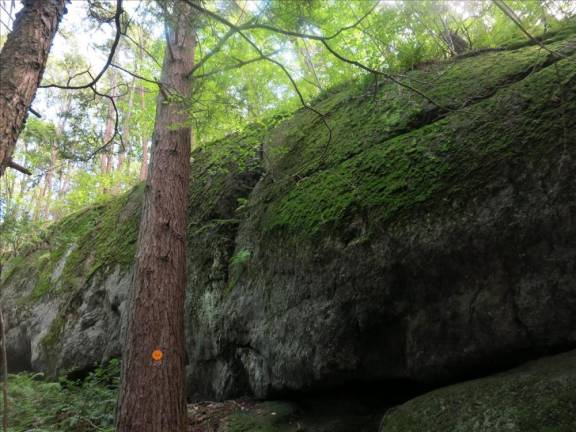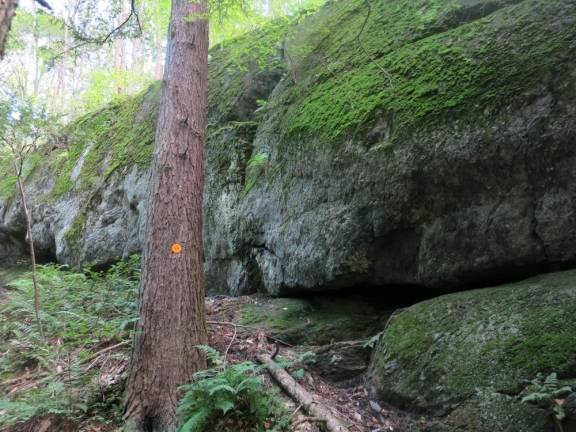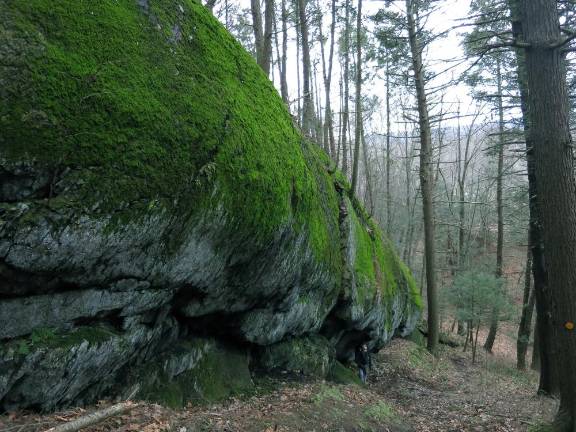Welcome to the Great Northwet
Water, water everywhere means gushing waterfalls, velvety moss carpets and mushrooms – and mosquitos – aplenty



We’ve traded places with the Northwest. It’s late summer, but the greens haven’t mellowed. In the valley below is a stunning patchwork of lime, mint, pea, olive, and apple, emerald, jade, turquoise and aquamarine.
It’s the Saturday after Hurricane Ida came roaring up from the Gulf, and every leaf, root and branch is watered well. The Minisink Trail is covered in springy green moss. It forms an iridescent ribbon that brightens the forest gloom and cushions our steps for miles.
We admire a large flat-topped rock covered with a thick, velvety carpet of pincushion moss and finely cut feather moss, whorls of trailing arbutus, and sprays of Christmas fern and maidenhair spleenwort. It looks like an altar to the goddess of chlorophyll. Water gushes at the lightest touch.
I wasn’t expecting this. Normally at this time of year, the leaves are starting to look ruddy, or jaundiced, as their red and yellow pigments slowly reveal themselves. This is the time of year when summer generally gets it right, having made its way through thunderstorms, heavy humidity, and hatch after hatch of winged biting insects to produce a few perfect days that, in February, we will remember as “summer.” The mosquitos cede the field. Weary homeowners get a break from their lawnmowers. But not this year.
For sure, I prefer this verdant, buggy lushness to the heat dome that dried the Northwest to a crisp. I read a first-person account by an Oregonian shocked to encounter brown, dry moss that felt brittle to the touch. We in the Northeast know that moss and lawns are resilient, and that a little rain will revivify even the driest expanses. Fall will come, but amid all this green I can fool myself it’s still peak summer.
I wrote about the Minisink-Lenape Ridge loop nearly 10 years ago, before it was dedicated in a trailhead ceremony by representatives of the Open Space Institute, the New York-New Jersey Trail Conference, and the Orange County Land Trust. The New York Department of Environmental Conservation has since taken it over, renaming its acquisition the Huckleberry Ridge State Forest. To get on the trail in the early days, you had to wade for a few tenths of a mile through thigh-high poison ivy. Poison ivy just doesn’t grow like this on the Sullivan County side of the border. Why is that? It may have to do with lands disturbed by farming. The “one dirt for every rock” landscape of my Sullivan County home has always resisted the plow. This trail just a few miles over the border is crisscrossed with stone walls that tell the story of cultivated plots of yore.
The poison ivy is gone now, and the mature trail provides easy footing through the arduous ups and down. But on one steep stretch, we encounter Ida’s destruction, where the rush of water tore the trail into a rough gully.
The trail passes by rock formations the size of whales, through mature stands of hemlock and juniper, and over lengths of exposed ridge sharpened to a knife’s edge. Every so often wide views open up over New York’s Neversink Valley to the north and New Jersey’s Kittatinny Ridge to the south.
The drawback here – also a plus, depending on how you look at it – is that the trail is sandwiched between New Jersey Transit’s Port Jervis line and Interstate 84. You’ll see at least one train whoosh by at startlingly close range, and on most legs of the trip you’ll hear the roar of the interstate. But my gratitude for these beautiful woods, and the trails that allow us to visit them, won out. They are forever preserved against the encroachments that usually accompany major commuter arteries, and offer much more solitude than can be found at marquee trails in famous parks.
On this gorgeous summer Saturday we saw only one other hiker, hunting for mushrooms on his way to a waterfall. It’s been a great season for both. He pointed to the black trumpets growing at our feet and brought out his phone to show his prize, hen of the woods. Then he was off, headed down the Lenape Ridge to his watery destination.
“It should be gushing,” he said with relish.
SNEAK PEEK
Trailhead: Route 6, Deerpark (south of Port Jervis)
Trails: Yellow-blazed Minisink Trail for 3.75 miles, then complete look via red-blazed Lenape Ridge Trail for 1.85 miles. Rejoin Minisink Trail for final 1.7 miles back to the trailhead. To do just the loop, park at the trailhead on Minisink Avenue (off Route 6).